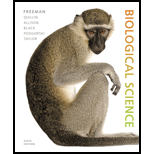
Concept explainers
Where does the citric acid cycle occur in eukaryotes?
a. in the cytosol of cells
b. in the intermembrane space of mitochondria
c. in the inner membrane of mitochondria
d. in the matrix of mitochondria
Introduction:
The citric acid cycle (CAC) or tricarboxylic acid cycle (TCA cycle) is a series of biochemical reactions, a stage of cellular respiration in cells that breakdowns the organic fuel molecules such as carbohydrates, proteins, and fats and releases energy through the oxidation of acetyl-CoA.
Answer to Problem 1TYK
Correct answer:
In the matrix of mitochondria
Explanation of Solution
Explanation/Justification for the correct answer:
Option (d) is given as mitochondrial matrix. Adenosine triphosphate (ATP) is classified as the source of energy in each cell in all the organisms. The conversion of glucose through a number of steps drives this energy conversion to ATP. One of the stages or a cycle is CAC. The space enclosed within the inner membrane of the mitochondria is called the matrix. The enzymes responsible for conducting the CAC are located in the matrix of the mitochondria. Hence, the Option (d) is correct.
Explanation for incorrect answers:
Option (a) is given as cell cytosol. The first stage of the breakdown of glucose is the glycolysis, where the end product is a 3-carbon compound called pyruvate. This reaction takes place in the cytosol in the eukaryotes. The space between the outer as well as the inner mitochondrial membranes and cristae make up the intermediate space, which contains no enzymes for these reactions. Hence, the option (a) is incorrect.
Option (b) is given as mitochondrial intermembrane space. The inner membrane of the mitochondria contains transporter proteins, which transfer the pyruvate to the mitochondrial matrix for further processing. Hence, the option (b) is incorrect.
Option (c) is given as mitochondrial inner membrane. Except glycolysis, all the enzymes for cellular respiration occur mostly in the mitochondrial matrix in the eukaryotes. Hence, the option (c) is incorrect.
The citric acid cycle (CAC) occurs in the matrix of mitochondria in eukaryotes.
Want to see more full solutions like this?
Chapter 9 Solutions
Biological Science (6th Edition)
- Molecular Biology Question A gene that codes for a protein was removed from a eukaryotic cell and inserted into a prokaryotic cell. Although the gene was successfully transcribed and translated, it produced a different protein than it produced in the eukaryotic cell. What is the most likely explanation?arrow_forwardMolecular Biology LIST three characteristics of origins of replicationarrow_forwardMolecular Biology Question Please help. Thank you For E coli DNA polymerase III, give the structure and function of the b-clamp sub-complex. Describe how the structure of this sub-complex is important for it’s function.arrow_forward
- Molecular Biology LIST three characteristics of DNA Polymerasesarrow_forwardMolecular Biology RNA polymerase core enzyme structure contains what subunits? To form holo enzyme, sigma factor is added to core. What is the name of the structure formed? Give the detailed structure of sigma factor and the function of eachdomain. Please help. Thank youarrow_forwardMolecular Biology You have a single bacterial cell whose DNA is labelled with radioactiveC14. After 5 rounds of cell division, how may cells will contain radioactive DNA? Please help. Thank youarrow_forward
- 1. Explain the structure and properties of atoms and chemical bonds (especially how they relate to DNA and proteins). Also add some pictures.arrow_forward1. In the Sentinel Cell DNA integrity is preserved through nanoscopic helicase-coordinated repair, while lipids in the membrane are fortified to resist environmental mutagens. also provide pictures for this question.arrow_forwardExplain the structure and properties of atoms and chemical bonds (especially how they relate to DNA and proteins). Also add some pictures.arrow_forward
- In the Sentinel Cell DNA integrity is preserved through nanoscopic helicase-coordinated repair, while lipids in the membrane are fortified to resist environmental mutagens. also provide pictures for this question.arrow_forward1. Explain how genetic information is stored, copied, transferred, and expressed. Also add some pictures for this question.arrow_forward!. Describe biological macromolecules (DNA, RNA, proteins, lipids, etc.) and how they function in the cell. also provide some images for this question.arrow_forward
 Human Biology (MindTap Course List)BiologyISBN:9781305112100Author:Cecie Starr, Beverly McMillanPublisher:Cengage Learning
Human Biology (MindTap Course List)BiologyISBN:9781305112100Author:Cecie Starr, Beverly McMillanPublisher:Cengage Learning Biology (MindTap Course List)BiologyISBN:9781337392938Author:Eldra Solomon, Charles Martin, Diana W. Martin, Linda R. BergPublisher:Cengage Learning
Biology (MindTap Course List)BiologyISBN:9781337392938Author:Eldra Solomon, Charles Martin, Diana W. Martin, Linda R. BergPublisher:Cengage Learning Human Physiology: From Cells to Systems (MindTap ...BiologyISBN:9781285866932Author:Lauralee SherwoodPublisher:Cengage Learning
Human Physiology: From Cells to Systems (MindTap ...BiologyISBN:9781285866932Author:Lauralee SherwoodPublisher:Cengage Learning Concepts of BiologyBiologyISBN:9781938168116Author:Samantha Fowler, Rebecca Roush, James WisePublisher:OpenStax College
Concepts of BiologyBiologyISBN:9781938168116Author:Samantha Fowler, Rebecca Roush, James WisePublisher:OpenStax College Human Heredity: Principles and Issues (MindTap Co...BiologyISBN:9781305251052Author:Michael CummingsPublisher:Cengage Learning
Human Heredity: Principles and Issues (MindTap Co...BiologyISBN:9781305251052Author:Michael CummingsPublisher:Cengage Learning Biology Today and Tomorrow without Physiology (Mi...BiologyISBN:9781305117396Author:Cecie Starr, Christine Evers, Lisa StarrPublisher:Cengage Learning
Biology Today and Tomorrow without Physiology (Mi...BiologyISBN:9781305117396Author:Cecie Starr, Christine Evers, Lisa StarrPublisher:Cengage Learning





